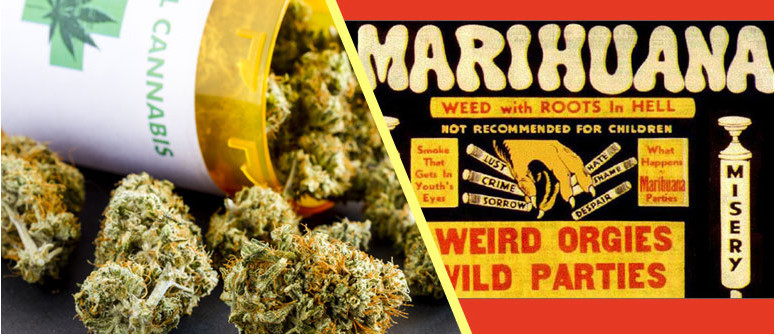Why we prefer cannabis over marijuana

The word "marijuana" has played a key role in creating the negative stigma around cannabis. Read here why we prefer cannabis over marijuana.
The cannabis plant has as many names as it does uses and is known and under many different labels. Weed, ganja, grass, herb, the list goes on and on. Many of these terms are slang words and even codes used to disguise the topic of conversation in dialog where the plant is illegal. However the most widespread and popular name given to what is officially and scientifically known as cannabis, is "marijuana".
Although this term is used on such a large scale, its true origin and meaning is rarely discussed or even questioned. It has been used and applied so rampantly that it is now highly ingrained into the industries and politics surrounding the cannabis plant. For example, in regions of the world where cannabis is available under medical use, acts, laws and advertising refer to it is "medical marijuana".
Is this term just one of many that surfaced due to the introduction of the herb into many different subcultures and scenes? Well there is evidence that points towards the possibility that its popularization was very intentional and somewhat sinister.
"Marijuana" is a word of Mexican-Spanish origin used, much as it is today, to refer to cannabis. Its passage into the United states is told by scholar Alan Piper, who explained, "The word marijuana, together with the use of herbal cannabis is an intoxicant, is consistently identified as coming into the USA from Mexico, being brought here by migrant workers".
Its use in western culture to describe the cannabis plant was not one that started on a positive note. In the 1930s America felt the devastating economic effects of what is now called The Great Depression. Several years prior to this event almost 1 million Mexican immigrants legally entered the United States, fleeing a war torn homeland.
The correlation here was enough to stir racial tensions alone, especially in an era where immigration was becoming heavily opposed. This was also the time frame in which cannabis prohibition was coming into full play, after hundreds of years of use as an industrial tool and medicinal herb.
A man by the name of Harry Anslinger was hired by the recently formed Federal Bureau of Narcotics, as its first director, in the year 1930. The bureau had been created to enforce the existing laws surrounding the prohibition of heroin and cocaine. Anslinger launched a campaign that railed against cannabis use in an attempt to have the substance classified among the ranks of the mentioned narcotics.
Yet this crusade was not a heroic act to protect the public from a real threat, based on science and truth. It was instead the action of a crooked alliance of individuals and institutions who were set to receive great person benefit from the prohibition of the herb.
Anslinger took perhaps the most damaging action that any individual has ever inflicted against the entire image and perception of cannabis. His crusade involved tying cannabis use to the racial groups that were partly being blamed for the economic crisis, and in doing mustered resentment towards both the plant and the minorities who used it for recreational purposes.
The sheer level of baseless propaganda and racial distortion that Anslinger was willing to fling around was demonstrated in a case where he testified before congress against cannabis, stating: "Marijuana is the most violence-causing drug in the history of mankind... Most marijuana smokers are Negroes, Hispanics, Filipinos and entertainers. Their satanic music, jazz and swing, result from marijuana usage."
Anslinger was also known to have said: "Reefer makes darkies think they're as good as white men... the primary reason to outlaw marijuana is its effect on the degenerate races".
These bizarre, extremist and out of touch views display that this ferocious attempt to prohibit cannabis use and smear it in the eyes of the public where not based on any clear science, but the fear igniting views of a corrupt racist in a high position of power.
None the less, such extremism worked. "Marijuana" was a term that spread throughout the nation, carrying negative connotations along with it.
William Randolf Hurst, cohort in this operation, was the most powerful newspaper owner in America during this time, putting him in a particularly unique position to sway public opinion. He began to print and distribute stories that were both false and massively distorted in order to inform the public about the evil menace that was marijuana.
One such barbarically misleading headline read, "Was it marijuana, the new Mexican drug, that nerved the murderous arm of Clara Phillips when she hammered out her victim's life in Los Angeles... Three-fourths of the crimes of violence in this country today are committed by dope salves - that is a matter of cold record."
The result of intelligently designed disinformation eventually led to the Marihuana Tax Act of 1937 that saw the federal criminalisation of cannabis in every state in America and a tax placed upon anyone who grew or traded the crop.
By this point the damage was done and the image of the poisonous and dangerous drug marijuana had replaced the medical and industrious cannabis herb in the minds of many.
Due to this dark period of cannabis history there is a growing and emerging movement that support the abandonment of the word marijuana to describe the cannabis plant because of the corruption surrounding it.
The modern era is becoming increasingly accepting of cannabis as a potent medicine and environmentally stable resource. Although marijuana is still used abundantly to name the herb, it may very well still pollute its image and serve as a tool to the collectives that still desire its imprisonment.




